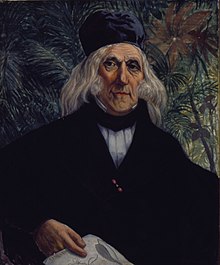
Augustin Saint-Hilaire

Augustin François César Prouvençal de Saint-Hilaire (4 October 1779 – 3 September 1853) was a French botanist and traveller who was born and died in Orléans, France. A keen observer, he is credited with important discoveries in botany, notably the direction of the radicle in the embryo sac and the double point of attachment of certain ovules. He also described two families, the Paronychiae and the Tamariscinae, as well as many genera and species.

Biography
He began to publish memoirs on botanical subjects at an early age. Between 1816 and 1822 and again in 1830, he traveled in South America, especially in south and central Brazil, and the results of his study of the rich flora of the regions through which he passed appeared in several books and numerous articles in scientific journals.[1]

In his first voyage, from 1816 to 1822, he explored the Brazilian backlands, traveling ca. 9,000 km, from Southeast Brazil to Río de la Plata, including the former Cisplatina Province (Uruguay). He was able to gather 24,000 specimens of plants, with 6,000 species, 2,000 birds, 16,000 insects and 135 mammals, plus many reptiles, mollusks and fishes. Most of these species were described for the first time. In the next years he devoted himself to the study, classification, description and publication of this huge material, but he was considerably impaired by his ill health, due to diseases contracted during the tropical travels. In 1819 he was appointed correspondent of the Académie des Sciences. He was awarded the Légion d'honneur at the level of Chevalier, and the Portuguese Order of Christ.[citation needed]

Works
The works by which he is best known are the Flora Brasiliae Meridionalis in three volumes (1825–1832), published in conjunction with Adrien-Henri de Jussieu and Jacques Cambessèdes, and illustrated by Pierre Jean François Turpin; Histoire des Plantes les plus Remarquables du Brésil et du Paraguay (1824), Plantes Usuelles des Brésiliens (1827–1828), also in conjunction with de Jussieu and Cambessèdes(1828); and Voyage Dans le District des Diamants et sur le littoral du Brésil, in two volumes (1833). His Leçons de Botanique, Comprénant Principalement la Morphologie Végetale (1840), was a comprehensive exposition of botanical morphology and of its application to systematic botany. He died at Orléans on 3 September 1853.[1]

List of selected publications
- Saint-Hilaire, A.F.C.P (1824). "Indication abrégée des plantes de la flore du Brésil méridional, qui appartiennent au groupe des Droséracées, des Violacées, des Cistées et des Frankeniées". Annales des Sciences Naturelles (in Latin). 2: 248––255.
- Saint-Hilaire, Auguste (1824). "Tableau monographique des plantes de la flore du Brésil méridional appartenant au groupe (classe Br.) qui comprend qui comprend les Droséracées, les Violacées, les Cistinées et les Frankenicées: Violacées". Annales du museum national d'histoire naturelle (in French). 72: 445–498.
See also
References
- ^ a b One or more of the preceding sentences incorporates text from a publication now in the public domain: Chisholm, Hugh, ed. (1911). "Saint-Hilaire, Augustin François César Prouvénçal de". . Vol. 24 (11th ed.). Cambridge University Press. p. 9.
- ^ International Plant Names Index. A.St.-Hil.
External links
 Works by or about Augustin Saint-Hilaire at Wikisource
Works by or about Augustin Saint-Hilaire at Wikisource
- French mycologists
- Pteridologists
- 1779 births
- 1853 deaths
- Botanists active in South America
- Members of the Bavarian Academy of Sciences
- Members of the Prussian Academy of Sciences
- Members of the French Academy of Sciences
- Corresponding members of the Saint Petersburg Academy of Sciences
- Scientists from Orléans
- 19th-century French botanists
See what we do next...
OR
By submitting your email or phone number, you're giving mschf permission to send you email and/or recurring marketing texts. Data rates may apply. Text stop to cancel, help for help.
Success: You're subscribed now !
